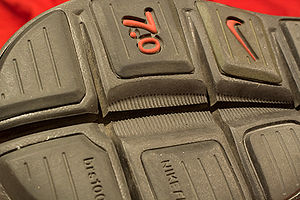
Nike Free
Encyclopedia

As this shoe allows the muscles in the foot to gain strength by providing less constriction, runners are advised to gradually break into the shoe rather than immediately running long distances as to prevent muscle cramps and other discomforts, such as the notorious shin splints
Shin splints
Shin splints or medial tibial stress syndrome refers to pain along or just behind the shins with sports that apply extreme pressure to the legs, such as gymnastics...
.
It was introduced in 2004 after Nike representatives observed some of the track athletes supplied by them were training barefoot. The numbering system indicates the cushioning of the shoe and follows a scale ranging from 0 (barefoot) to 10 (normal running shoe), i.e. Free 3.0 being the least and Free 7.0 being the most cushioned model so far. It is unclear why each model is numbered x.0, rather than just x.
Nike started the Free series with the Free 5.0 in 2005 and in 2006 released a new version of the shoe, the Nike Free 5.0 V2, that addressed some of the durability issues in the earlier model. Among other changes, the heel and sidewalls of the shoe were redesigned to prevent tearing.
Since then, the Nike Free 5.0 V3 (2007) and Nike Free 5.0 V4 (2009) models have been released along with various other models from the Nike Free 3.0 V1 and V2 to the Nike Free 7.0 V1 and V2.
Nike has been sued by Reebok
Reebok
Reebok International Limited, a subsidiary of the German sportswear company Adidas since 2005, is a producer of Athletic shoes, apparel, and accessories. The name comes from the Afrikaans spelling of rhebok, a type of African antelope or gazelle...
over claims about the patented "flexible sole" design. Allegedly, the shoe was designed by Reebok, but had never been manufactured for a lack of market. With the re-emergence of thin soled shoes in various sports (basketball, powerlifting, and general weight-lifting, etc.), the market has grown considerably.

